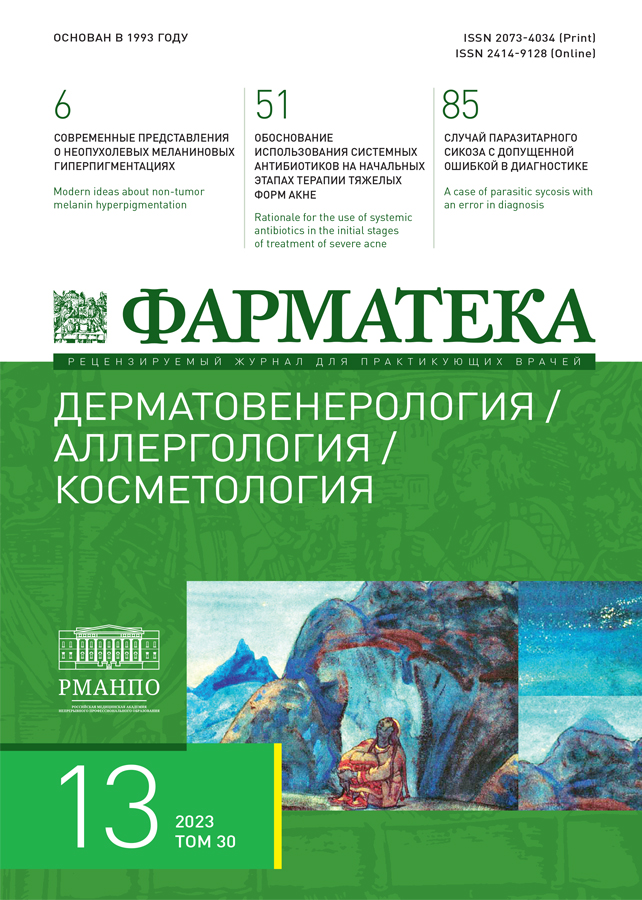Efficacy of dupilumab in children with alopecia areata and atopic dermatitis
- Authors: Dogov А.M.1, Murashkin N.N.1,2,3, Ambarchyan E.T.4
-
Affiliations:
- National Medical Research Center for Children’s Health
- Sechenov University
- Central State Medical Academy of the Administrative Department of the President of the Russian Federation
- Research Institute of Pediatrics and Children’s Health, Central Clinical Hospital of the Russian Academy of Sciences
- Issue: Vol 30, No 13 (2023)
- Pages: 59-62
- Section: Original articles
- URL: https://journals.eco-vector.com/2073-4034/article/view/625941
- DOI: https://doi.org/10.18565/pharmateca.2023.13.59-62
- ID: 625941
Cite item
Abstract
Background. Atopic dermatitis (AD) is a multifactorial, genetically determined, inflammatory skin disease characterized by itching, chronic relapsing course and age-related features of the localization and morphology of lesions. AD is an atopic disease with a dominant role of T helper cells type 2 (Th2), increased levels of interleukins (IL-4, -5, -13 and -31), which forms IgE-mediated sensitization and inflammation. Alopecia areata (AA) is an autoimmune disease characterized by CD8+ T cell-mediated hair loss. Although AA has historically been classified as a process driven primarily by T helper type 1 (Th1) cells, findings from genomic susceptibility loci and cytokine activation support the involvement of the Th2 pathway. Accordingly, dupilumab, an IL-4 receptor antagonist that suppresses the Th2 response, may represent an effective drug for the treatment of severe forms of AA.
Objective. Evaluation of the effectiveness of dupilumab in children with AA and AD.
Methods. A cross-sectional retrospective cohort study was conducted. The mean age of the patients was 11,3±2,8 years (range, 7 to 18 years). A total of 12 patients took part in the study, including 7 girls and 5 boys. Patients were administered dupilumab by subcutaneous injection at a dose of 600 mg, followed by 300 mg every 2 weeks. The median duration of treatment with dupilumab was 24 weeks (median 29.4, range 20–54). To assess the effectiveness of treatment for HA and AD, the SALT (Severity Alopecia Tool) scale and the Eczema Area and Severity Index (EASI) were used.
Results. After 24 weeks of dupilumab treatment, patients’ mean SALT score decreased from 71.9 to 25.2. All patients treated with dupilumab experienced significant regression of skin lesions and a significant reduction in EASI scores. The mean EASI score in patients before initiation of dupilumab was 52.3 and decreased to 8.15 after 24 weeks of treatment.
Conclusion. The results obtained indicate that dupilumab may be effective in the treatment of severe forms of AA in children with AD.
Keywords
Full Text
About the authors
А. M. Dogov
National Medical Research Center for Children’s Health
Email: pharmateca@yandex.ru
ORCID iD: 0000-0001-9719-1656
Russian Federation, Moscow
N. N. Murashkin
National Medical Research Center for Children’s Health; Sechenov University; Central State Medical Academy of the Administrative Department of the President of the Russian Federation
Author for correspondence.
Email: m_nn2001@mail.ru
ORCID iD: 0000-0003-2252-8570
Dr. Sci. (Med.), Head of the Department of Dermatology with the Laser Surgery Group of the Center for Pediatric Dermatology, Head of the Laboratory of Skin Pathology in Children, Professor at the Department of Dermatovenereology and Cosmetology, Professor at the Department of Pediatrics and Pediatric Rheumatology
Russian Federation, Moscow; Moscow; MoscowE. T. Ambarchyan
Research Institute of Pediatrics and Children’s Health, Central Clinical Hospital of the Russian Academy of Sciences
Email: pharmateca@yandex.ru
ORCID iD: 0000-0002-8232-8936
Russian Federation, Moscow
References
- Атопический дерматит. Клинические рекомендации. 2020. [Atopic dermatitis. Clinical recommendations. 2020. (In Russ.)].
- Альбанова В.И., Пампура А.Н. Атопический дерматит. 2-е изд. М., 2020. [Albanova V.I., Pampura A.N. Atopic dermatitis. 2nd ed. M., 2020. (In Russ.)]. doi: 10.33029/9704-5640-8-АТП-2020-1-144.
- Ivert L.U., Wahlgren C.-F., Lindelof B., et al. Association between atopic dermatitis and autoimmune diseases: a population-based case-control study. Br J Dermatol. 2021;185(2):335–42. doi: 10.1111/bjd.19624.
- Barahmani N., Schabath M.B., Duvic M. History of atopy or autoimmunity increases risk of alopecia areata. J Am Acad Dermatol. 2009;61(4):581–91. doi: 10.1016/j.jaad.2009.04.031.
- Renert-Yuval Y., Guttman-Yassky E. A novel therapeutic paradigm for patients with extensive alopecia areata. Еxpert Opin Biol Ther. 2016;16:1005–14.
- Mohan G.C., Silverberg J.I. Association of vitiligo and alopecia areata with atopic dermatitis: a systematic review and meta-analysis. JAMA Dermatol. 2015;151(5):522–28. doi: 10.1001/jamadermatol.2014.3324.
- Harada K., Irisawa R., Ito T., et al. The effectiveness of dupilumab in patients with alopecia areata who have atopic dermatitis: a case series of seven patients. Br J Dermatol. 2020;183(2):396–97 doi: 10.1111/bjd.18976.
- Xing L., Dai Z., Jabbari A., et al. Alopecia areata is driven by cytotoxic T lymphocytes and is reversed by JAK inhibition. Nat Med. 2014;20: 1043–49.
- Suarez-Farinas M., Ungar B., Noda S., et al. Alopecia areata profiling shows TH1, TH2, and IL-23 cytokine activation without parallel TH17/TH22 skewing. J Allergy Clin Immunol. 2015;136:1277–78.
- Zhang X., McElwee K.J. Allergy promotes alopecia areata in a subset of patients. Exp Dermatol. 2020;29:239–42.
- Jagielska D., Redler S., Brockschmidt F.F., et al. Follow-up study of the first genome-wide association scan in alopecia areata: IL13 and KIAA0350 as susceptibility loci supported with genome-wide significance. J Invest Dermatol. 2012;132:2192–97.
- Czarnowicki T., He H.Y., Wen H.C., et al. Alopecia areata is characterized by expansion of circulating Th2/Tc2/Th22, within the skin‐homing and systemic T-cell populations. Allergy. 2018;73:713–23.
- Marks D.H., Mesinkovska N., Senna M.M. Cause or cure? Review of dupilumab and alopecia areata. J Am Acad Dermatol. 2023;88(3):651–653. doi: 10.1016/j.jaad.2019.06.010
Supplementary files








